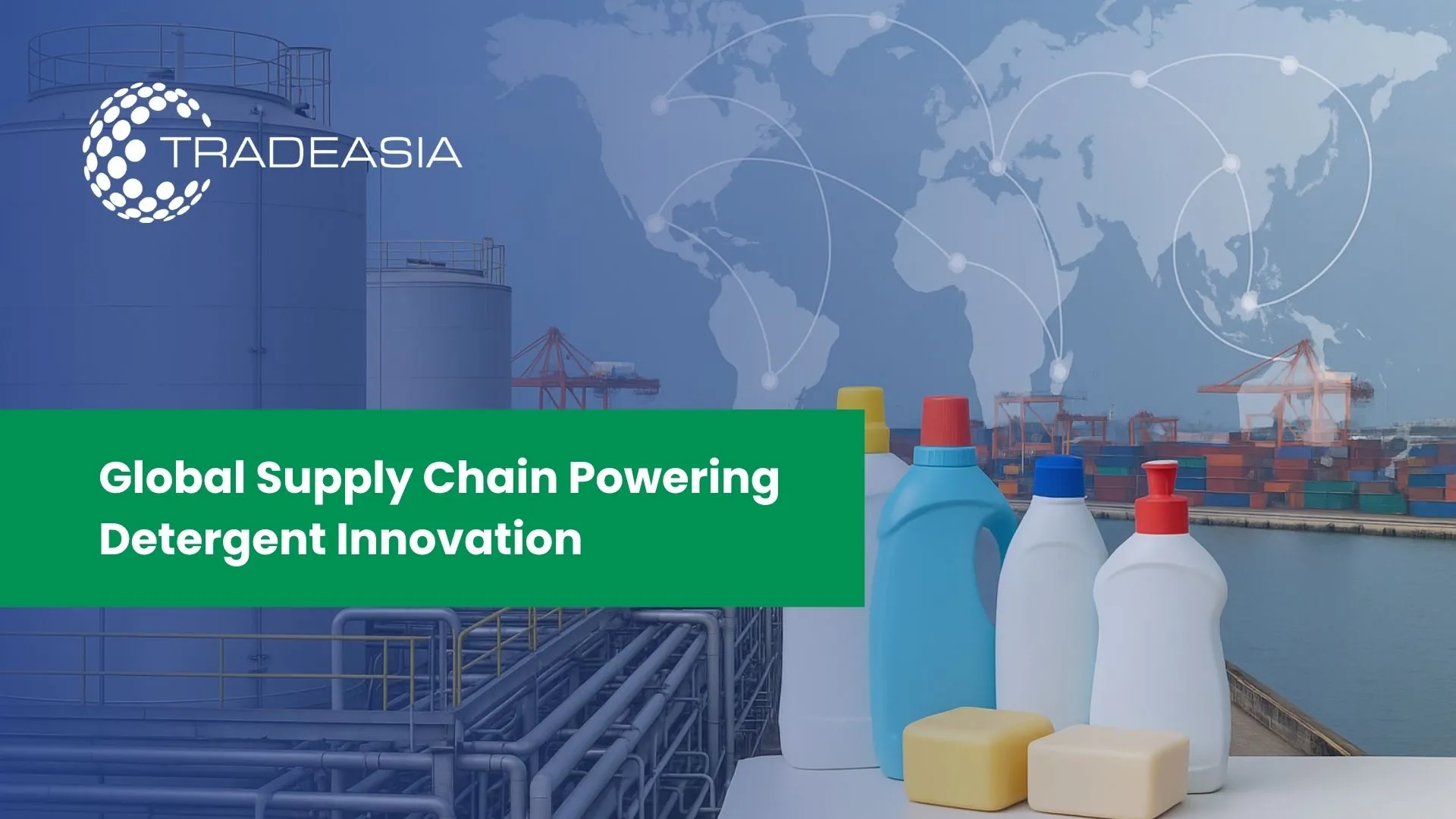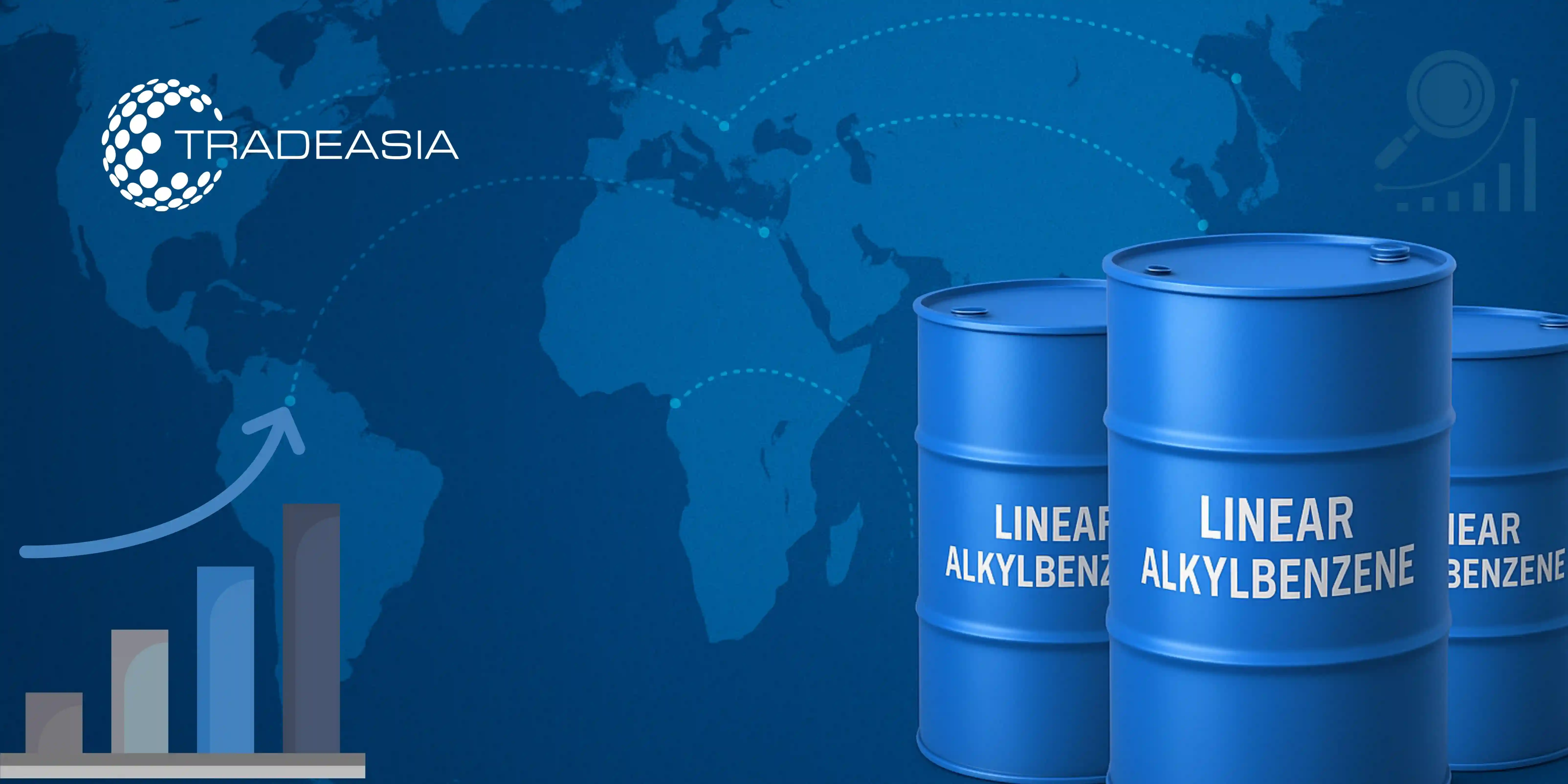Introduction to Linear Alkylbenzene and Its Industrial Role
Linear Alkylbenzene (LAB) is a vital organic compound and one of the most important intermediates used in the production of Linear Alkylbenzene Sulfonic Acid (LABSA), the key surfactant for manufacturing household detergents, soaps, and cleaning chemicals. Its linear molecular structure provides superior biodegradability compared to older branched surfactants, making it an environmentally preferred option.
LAB serves as the backbone of the global detergent industry, powering formulations that deliver high foaming, effective grease removal, and chemical stability. Its demand is tightly linked with population growth, rising hygiene awareness, and industrial development across both developed and emerging markets.
Between 2025 and 2030, the global LAB market is expected to evolve rapidly, influenced by trade diversification, capacity expansions, and sustainability regulations. Understanding its trade flow, key exporters, and supply chain structure is essential for businesses operating in the soap and detergent value chain.
Chemical Characteristics and Importance in Soap & Detergent Formulations
Chemically, Linear Alkylbenzene is a hydrocarbon compound produced through the alkylation of benzene with linear olefins derived from kerosene fractions. The linear structure allows LAB to produce surfactants that are both powerful and biodegradable critical for meeting modern environmental standards.
In detergent formulations, LAB-derived surfactants provide the perfect balance between cleaning efficiency and ecological compatibility. LABSA, its primary derivative, is neutralized with sodium hydroxide or ammonia to form sodium linear alkylbenzene sulfonate (LAS), the key active ingredient in most liquid and powder detergents.
Its versatility allows use across a wide product range from household cleaning agents like laundry powders and dishwashing liquids to industrial applications such as emulsifiers and degreasers. This cross-sector demand ensures that LAB remains one of the top-traded petrochemical intermediates in the world.
Overview of Global Linear Alkylbenzene Trade
The global trade of Linear Alkylbenzene operates within a well-defined supply chain that connects feedstock producers, LAB manufacturers, detergent formulators, and distributors. The largest share of LAB is traded regionally, particularly in Asia and the Middle East, where production capacities are expanding rapidly.
According to IMARC Group and Mordor Intelligence, the global LAB market was valued at approximately USD 10 billion in 2024, and is expected to grow at a CAGR of 4–5% through 2030. This growth is fueled by increasing detergent consumption, expanding middle-class populations, and infrastructure development that boosts hygiene standards.
Trade routes for LAB are primarily maritime, leveraging major export hubs in the Middle East, South Asia, and Western Europe. Singapore, with its strategic location and port infrastructure, continues to serve as a key logistics and redistribution hub for LAB across Southeast Asia.
Key Exporting Countries and Production Hubs (2025 - 2030)
Several countries dominate the production and export of Linear Alkylbenzene due to their integrated petrochemical infrastructure and access to low-cost raw materials.
-
Saudi Arabia
Saudi Arabia leads global LAB exports, driven by major petrochemical producers such as SABIC and Farabi Petrochemicals. The nation benefits from abundant availability of benzene and kerosene fractions, coupled with world-class refineries. Its strategic location allows cost-efficient exports to Africa, Asia, and Europe.
-
India
India has emerged as both a significant producer and exporter, thanks to its rapidly expanding detergent and chemical manufacturing base. Companies like Reliance Industries and Tamilnadu Petroproducts Limited are expanding capacity to meet domestic and international demand, positioning India as a future LAB export hub for Asia-Pacific.
-
South Korea & Thailand
Both countries maintain advanced petrochemical networks, focusing on high-purity LAB production for export to regional detergent manufacturers. Their proximity to growing Southeast Asian markets provides competitive advantages in logistics and turnaround time.
-
Europe (Spain and Italy)
European producers like CEPSA and Petresa play a major role in supplying LAB to Africa and the Americas. Despite higher production costs, European LAB is known for consistent quality and adherence to environmental standards, making it preferred by premium detergent brands.
Regional Consumption and Import Trends
Asia-Pacific represents the largest LAB consumption region, accounting for nearly 45% of global demand. China, India, Indonesia, and Vietnam are key importers, driven by their massive detergent production and rising urban populations. These nations also serve as centers for contract manufacturing of private-label cleaning products.
Africa has seen significant growth in LAB imports, primarily from the Middle East and Europe. The continent’s expanding consumer base and industrial modernization initiatives are accelerating demand for household detergents and cleaning chemicals.
In Latin America, countries such as Brazil and Mexico are leading detergent producers, sourcing LAB mainly from North American and Middle Eastern suppliers. Growing consumer preference for biodegradable products further strengthens the position of LAB in these regions.
Supply Chain Dynamics and Distribution Models
The global LAB supply chain is structured around three key components: feedstock sourcing, LAB production, and downstream distribution. Feedstock, including linear olefins and benzene, typically comes from integrated refineries and petrochemical plants. This vertical integration ensures efficiency and cost control.
LAB producers often operate export-oriented facilities located near major ports for direct shipment. These facilities rely on long-term supply contracts with detergent manufacturers to ensure stable demand. Singapore’s Jurong Island serves as a model for this integration, offering shared logistics, chemical storage, and pipeline networks that optimize cost efficiency.
Distributors and trading companies play a crucial role in managing regional inventories and bridging supply-demand gaps. In Southeast Asia and Africa, traders often act as liaisons between global producers and local detergent manufacturers, ensuring that product quality, transportation safety, and regulatory compliance are consistently maintained.
Price Drivers and Trade Challenges
The pricing of Linear Alkylbenzene is influenced by several factors, primarily raw material costs (benzene and kerosene), energy prices, and freight rates. Fluctuations in crude oil prices directly impact production margins and export competitiveness.
Global trade is also subject to environmental regulations and tariff structures. Countries implementing stricter emission norms or import duties may experience short-term supply constraints, leading to price volatility. Logistics disruptions such as port congestion or maritime route changes can also influence trade flow efficiency.
However, technological innovation and expanded regional production capacity are expected to mitigate price volatility over the next five years. The trend toward long-term supply contracts and localized production partnerships will enhance trade stability and improve overall cost competitiveness in the detergent chemicals sector.
Technological and Sustainability Advancements in LAB Production
Modern LAB production is shifting toward sustainable and energy-efficient processes. Technologies such as detergent alkylate processes (DETAL) have replaced older hydrofluoric acid routes, offering higher yield and lower environmental impact.
Producers are also investing in green chemistry solutions, exploring renewable feedstocks derived from bio-based kerosene and plant oils. While still in pilot phases, these initiatives aim to reduce carbon emissions and enhance the overall sustainability of LAB manufacturing.
In addition, digitalization and AI-driven predictive maintenance systems are being implemented in major production facilities. These innovations reduce downtime, improve quality control, and optimize resource use all crucial factors for maintaining competitiveness in the global market.
Strategic Outlook and Future Opportunities
Between 2025 and 2030, the global trade dynamics of Linear Alkylbenzene will be shaped by demand expansion in emerging economies and ongoing sustainability reforms. Manufacturers are expected to focus on regional diversification to reduce dependency on a limited number of production centers.
Strategic partnerships between chemical producers, distributors, and detergent manufacturers will become more prevalent. These collaborations will focus on securing raw material supply, developing eco-friendly surfactant variants, and ensuring resilient logistics frameworks.
The future of LAB trade lies in its integration into the circular economy utilizing renewable feedstocks, improving energy efficiency, and adopting closed-loop production systems. Singapore and the Middle East are poised to lead these transformations, reinforcing their positions as key players in the global detergent supply chain.
Conclusion
Linear Alkylbenzene stands as a cornerstone chemical in the soap and detergent industry, underpinning the global trade ecosystem for surfactant production. Its unique combination of efficiency, biodegradability, and scalability ensures continued relevance across both developed and emerging markets.
From Saudi Arabia’s vast petrochemical capacity to Singapore’s strategic logistics hub, the global trade of LAB reflects a well-orchestrated network of production, supply, and innovation. Between 2025 and 2030, this network will continue evolving toward greater sustainability, efficiency, and resilience.
As the world moves toward a cleaner and more resource-conscious future, Linear Alkylbenzene’s trade and production will remain central to sustainable detergent manufacturing connecting economies, industries, and consumers across the globe. For more information on Linear Alkylbenzene sourcing, trade insights, or supply partnerships across Asia’s detergent industry, connect with our team at Detergent Chemicals Asia.
References


Leave a Comment